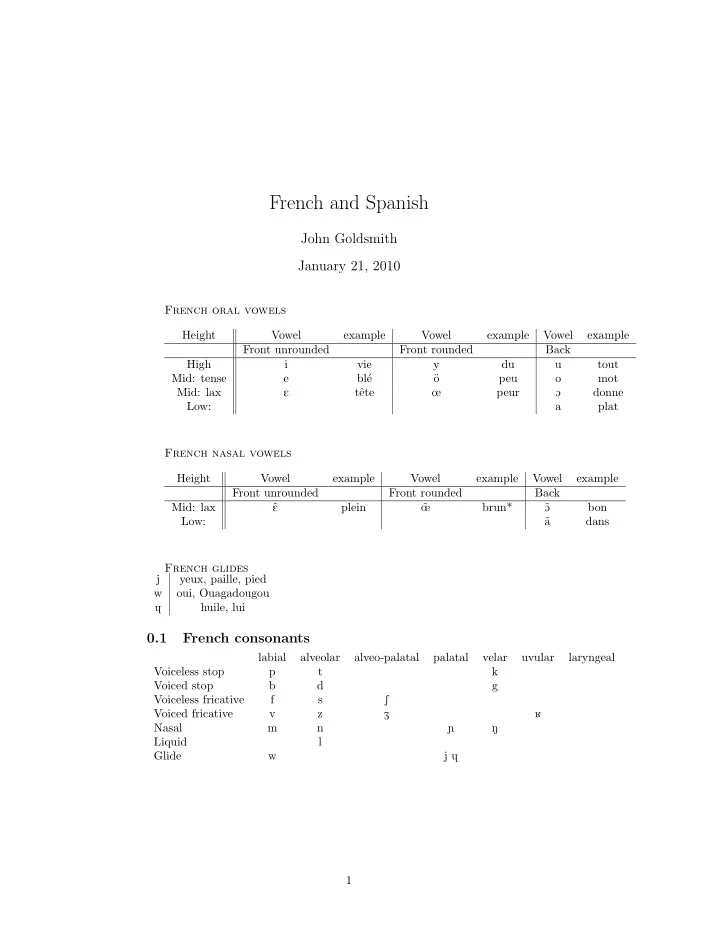

French and Spanish John Goldsmith January 21, 2010 French oral vowels Height Vowel example Vowel example Vowel example Front unrounded Front rounded Back High i vie y du u tout Mid: tense e bl´ e o ¨ peu o mot Mid: lax E tˆ ete œ peur O donne Low: a plat French nasal vowels Height Vowel example Vowel example Vowel example Front unrounded Front rounded Back Mid: lax plein brun* bon E ˜ œ ˜ ˜ O Low: ˜ a dans French glides j yeux, paille, pied w oui, Ouagadougou huile, lui 4 0.1 French consonants labial alveolar alveo-palatal palatal velar uvular laryngeal Voiceless stop p t k Voiced stop b d g Voiceless fricative f s S Voiced fricative v z Z K Nasal m n ñ N Liquid l Glide w j 4 1
1 SPANISH Spelling English Qu´ eb´ ecois Continental tout, toute all t U t tu, tut vous, nous you, us vu, nu vu, nu riz rice ri ri du of the, some d z y dy vite quickly v I t vit parler to speak pa K le pa K le Colette (name) k O l E t k O l E t Table 1: Qu´ eb´ ecois laxing (relˆ achement vocalique Spelling English Qu´ eb´ ecois Continental petit small p ţ i p @ ti tiroir drawer ţ irwa K tirwa K diable devil d z jab djabl @ Ad` ele (name) ad E l ad E l terre earth t EK t EK tˆ ache task ta: S ( or taw S ) ta S tout all t U t tu il dit he says i d z i i(l)di elle dit she says a d z i E ldi planter to plant pl˜ ante pl˜ ante torchon dish towel t OKS ˜ o t OKS ˜ o tiens hold, take ţ j˜ e tj˜ e tuer to kill ţ ye tye dur hard d z yr dyr diable devil d z jab djabl @ dans in d˜ a d˜ a petite image small picture p ţ itima: Z p @ titima Z 1 Spanish Spanish vowels Height Vowel example Vowel example Vowel example Front unrounded Front rounded Back High i vida u su Mid e dedo o dedo Low: a agua 2
1.1 Spanish consonants 1 SPANISH Rounded vowels u i High vowels e o Mid vowels a Low vowels Front vowels Central vowels Back vowels Figure 1: Spanish vowels 1.1 Spanish consonants bilabial labio-dental dental alveolar alveo-palatal palatal velar Voiceless stop p t k Voiced stop b d g Voiceless affricate Ù Voiceless fricative f s ( S ) x θ Voiced fricative ( Z ) B D G Nasal m n ñ N Lateral l L Glide w j 4 1.2 Spanish aspiration: educated Porte˜ no mas more mah G rande bigger tom´ ar to take, to drink tom´ as you take (2nd sg.) ´ a G wa water tom´ ahmas´ a G wa you take more water mol´ ehta bothers (3rd. sg. verb present tense b´ ohke forest ´ ase does (3rd. sg. verb present tense 3
1.3 Stop/spirant relationship 2 GERMAN VELAR FRICATIVE 1.3 Stop/spirant relationship bala ball beso kiss su B eso his/her kiss umbeso a kiss el B eso the kiss dar B esos to give kisses de D o finger elde D o the finger su D e D o his/her finger mi D e D o my finger unde D o a finger gato cat u N gato a cat mi G ato my cat el G ato the cat 2 German velar fricative In German, 1 we find two sounds corresponding to the spelling ch . One of them is a palatal fricative, [¸ c], as in the word ich , which means I, and the other is a velar fricative, [x], as in the word Mach . Most of the occurrences of these sounds occur after the first vowel of the word; here are some typical examples: a. Bu[x] book B¨ u[¸ c]er books b. Lo[x] hole L¨ o[¸ c]er holes c. Ba[x] brook B¨ a[¸ c]e brooks d. Bau[x] belly B¨ au[¸ c ] bellies e. i[¸ c] I f. bre[¸ c]en break g. Lei[¸ c]e body (corpse?) h. man[¸ c] many i. Dol[¸ c] dagger j. dur[¸ c] through The examples in a-g suggest a simple generalization, and it does indeed hold for a very large proportion of the data: [¸ c] appears after a front vowel, and [x] appears after a back vowel. The examples in i-j illustrate another fact, which is that when we consider words where the ch appears after the first vowel and a consonant—we might say, in the environment C 0 V S , where S can be n,l, or r—then we always find [¸ c]. It is not only tempting, it is nearly right, to say: 1 Based on Orrin Robinson, Whose German?, passim. Moulton Modern German Juncture, p. 214, 1947, says The voiceless spirants [¸ c] and [x] are in complementary distribution with each other; [x] occurs only after central and back vowels and semivowels: [b a x] ‘brook’, [na:x] ’towards’, [n O x] ‘still’, [ho:x] ‘high’, [b γ u x]‘breach’, [bu:x] ‘book’,[ P a wx] ‘also’; [¸ c] occurs only after front vowels and semivowels, and after consonants: [m i ¸ c] ‘me’ [p‘ ǫ ¸ c] ‘hard luck’, [k‘ γ i:¸ ct] ‘crawls’, [ne:¸ cst] ‘next’, [hø:¸ cst] ‘highest’, [ γ a j¸ c] ‘rich’,[ PO j¸ c] ‘you’, [ P ǫ l¸ c] ‘elk’, [mœn¸ c] ‘monk’, [d u γ ¸ c] ‘through’. We may therefore analyze [¸ c] and [x] as allophones of a single phoneme /x/. 4
2 GERMAN VELAR FRICATIVE In German, the phoneme /x/ surfaces as [x] immediately after a back vowel, and as [¸ c] elsewhere. a. Frau[¸ c]en mistress (of an animal) b. H¨ aus[¸ c]en little house c. Kuh[¸ c]en little cow 5
Recommend
More recommend